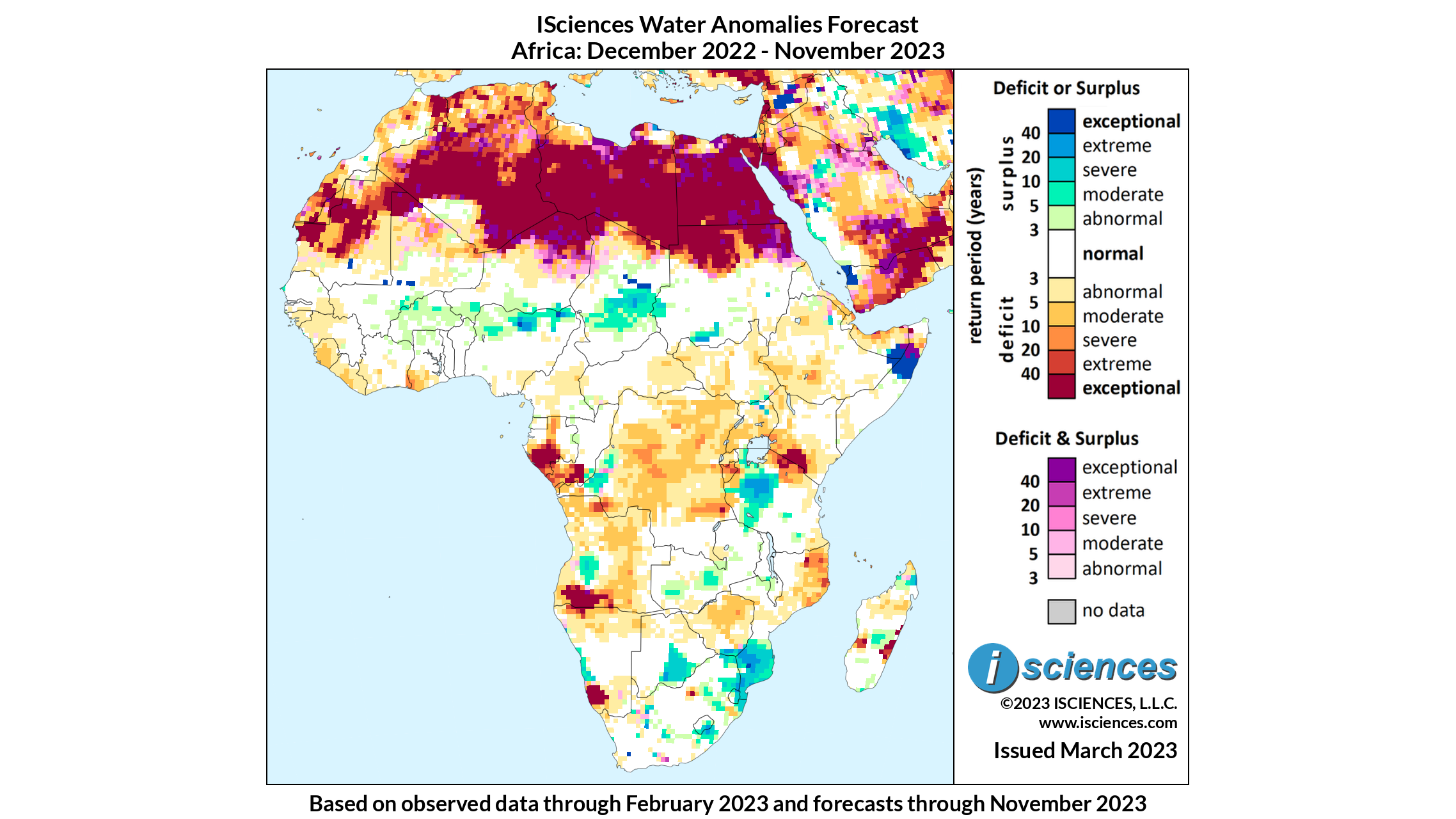Africa: Deficits persist in Horn of Africa, N Africa
29 March 2023
THE BIG PICTURE
The 12-month forecast ending in November 2023 indicates widespread anomalies of varying intensity, with deficits spanning across most of its southern regions, and intense surpluses persisting south of the Sahel.
Exceptional deficits are expected in:
Central to northern Mauritania, spreading across its western coast through regions near Fderik, into northern Mali and the majority of Algeria.
Eastern Morocco, near the city of Oudja.
Southern Gabon, in regions southeast of the Ngounie River.
Southwestern Angola, near the town of Cahama.
Southwestern Namibia, in western coastal areas of Karas.
Eastern coastal regions of Madagascar, near the city of Farafangana.
Moderate to severe deficits are anticipated in:
Northeastern Central African Republic, in the Haute-Kotto prefecture.
Northern countries in the Horn of Africa, particularly northern Somalia.
Throughout the Democratic Republic of the Congo.
North-central to southeastern Angola, near the town of Milunga, spreading further south.
Sierra Leone.
Severe to extreme surpluses are forecast in:
The shared borders of northern Nigeria and southern Niger.
East-central Chad, spreading along its shared border with western Sudan.
Western Democratic Republic of Congo, along the Congo River.
West-central Tanzania, in regions near the Igombe River.
Throughout Lesotho, spreading through southeastern South Africa.
Central Madagascar, in areas north of the Mananantanana River, as well as northern areas of the country near Antsahakarany.
The 3-month maps (below) show the evolving conditions in more detail.
FORECAST BREAKDOWN
The forecast through May 2023 predicts that a few areas of exceptional anomalies in northern Africa are expected to subside into mild to moderate deficits, though continuing in Egypt and Libya. Exceptional deficits in the Horn of Africa are expected to become exceptional surpluses. Much of the southern Sahel can expect intense surpluses to persist, throughout Burkina Faso and southern Sudan, becoming widespread throughout Chad. Other regions with a forecast of surplus include southeastern Zambia, southern Botswana, eastern Zimbabwe, southern Mozambique, and central Tanzania. Pockets in eastern South Africa are expected to persist, though slightly downgraded to moderate surpluses.
From June through August 2023, exceptional deficits are expected to continue in Libya, Egypt, and northern Sudan. Western Algeria can expect deficits of similar intensity to reemerge. Surpluses in the south Sahel will persist but downgrade to mild intensities. Transitional conditions in the Horn of Africa are also expected to endure, with mild to moderate deficits covering most central and southern areas of the continent.
The forecast for the final months – September through November 2023 – expects extreme to exceptional deficits to continue in southeastern Libya, southwestern Egypt, and western Algeria. Surpluses in the Sahel are expected to mostly diminish, with some surpluses remaining in eastern Chad. The rest of the continent can anticipate normal conditions to mild anomalies. Please note that WSIM forecast skill declines with longer lead times.
IMPACTS
The Horn of Africa is currently experiencing the worst drought it has seen in 73 years. As the area faces its sixth consecutive season of insufficient rainfall, 15 million people across Ethiopia, Eritrea, Kenya, Somalia, and Sudan are facing hunger and water shortages. In Ethiopia, Kenya, +and Somalia, over 36 million people are estimated to require emergency assistance, and up to 26 million of them are acutely food insecure.
On March 24, the governments of Ethiopia and the Netherlands called for construction of a Groundwater Access Facility (GaFa) to provide water to the Horn of Africa. The use of a GaFa would allow sustainable use of untapped groundwater reservoirs in the region which hold millions of cubic kilometers of water, which will be provided to areas that are most affected by drought and food insecurity.
A new report from the Somalian government and United Nations states the first official death toll caused by the drought, totaling around 43,000. Half of the fatalities are assumed to be children under five. Experts believe that the crisis is far from over, as between 18,000 to 34,000 more deaths are expected to happen within the first six months of 2023.
Tunisian authorities have begun restricting drinking water at night in areas of the capital, as well as other cities,to reduce consumption in an effort to combat water scarcity across the country. In areas of the capital Tunis, Hammamet, Sousse, Monastir and Sfax, water was cut off without announcement, which threatens to fuel social tension in a country whose people suffer from poor public services, high inflation, and a weak economy.
NOTE ON ADMINISTRATIVE BOUNDARIES
There are numerous regions around the world where country borders are contested. ISciences depicts country boundaries on these maps solely to provide some geographic context. The boundaries are nominal, not legal, descriptions of each entity. The use of these boundaries does not imply any judgement on the legal status of any territory, or any endorsement or acceptance of disputed boundaries on the part of ISciences or our data providers.
Subscribe to our monthly Water Watch List
Search blog categories
- *Precip/Temp Outlooks 101
- *Press Releases 1
- *Special Topics 19
- *Water Watch Lists 119
- Africa 129
- Australia & New Zealand 113
- Canada 115
- Central Asia & Russia 113
- East Asia 114
- Europe 120
- Mexico & C. Amer. & Carib 118
- Middle East 123
- Proof Point 1
- South America 128
- South Asia 119
- Southeast Asia & Pacific 122
- United States 119
Search blog tags



